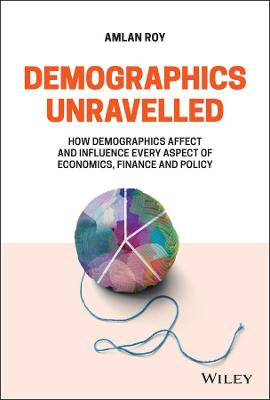Demographics Unravelled
 -15%
portes grátis
-15%
portes grátis
Demographics Unravelled
How Demographics Affect and Influence Every Aspect of Economics, Finance and Policy
Roy, Amlan
John Wiley & Sons Inc
01/2022
320
Dura
Inglês
9781119799139
15 a 20 dias
602
Descrição não disponível.
Acknowledgements xv
Selected Abbreviations xvii
Preface xix
Chapter 1: Introduction 1
1.1 Recasting Demographics 2
1.2 Effects and Implications of Demographics 5
Chapter 2: Core Data: Past, Present, and Future 11
2.1 Economic History and the History of Global Population Trends 13
2.2 Core Demographic Variables: Data, Analysis, and Some Observations 16
2.2.1 Population Size and Population Growth 16
2.2.2 Ageing Populations 18
2.2.3 Life Expectancy Increases 20
2.2.4 Total Fertility Rates 21
2.2.5 Dependency Ratios 23
2.2.6 Gender Ratios 26
2.2.7 Age Structure and Population Pyramids 29
2.2.8 The Demographic Transition Model 32
2.3 The Role of Migration 35
2.4 Urbanisation 46
2.5 Small Nation- States: Demographics 50
2.6 Changing Longevity- Metrics Need Changing 51
2.7 Changing Social and Individual Behaviour 53
2.8 Multiple Generations 55
2.9 Conclusion 57
Chapter 3: Demographics and Macroeconomics 59
3.1 Demographics and Economic Growth 60
3.2 The "Demographic Dividend" and GDP per Capita Growth 66
3.3 Inflation 70
3.4 Debt, Deficits, and Fiscal Sustainability 84
3.5 Demographics, Monetary Policy, and Interest Rates 90
3.6 Demographics and Unemployment 93
3.7 Demographics, Capital Flows, and Current Account 95
3.8 Conclusions 96
Chapter 4: Demographics and Asset Prices 99
4.1 Theories of Life- Cycle Consumption, Savings, and the Permanent Income Hypothesis 100
4.1.1 Life- Cycle Consumption Theory 100
4.1.2 Permanent Income Hypothesis 102
4.1.3 Consumption, Savings, and Intertemporal Loans: Pioneer Paul Samuelson 104
4.2 How Demographics Influences Equity Prices and Markets 105
4.3 Will There Be an Asset Market Meltdown When the Baby Boomers Retire? 116
4.4 Demographic Changes and Interest Rates (Bond Yields) 119
4.5 Demographics and Risk Premiums 124
4.6 Asset Holdings and Age 125
4.7 Demographics and Equity Sectors 128
4.8 Demographics and Real Estate 136
4.9 Demographics and Commodities 140
4.10 Conclusions 143
Chapter 5: Health and Longevity 147
5.1 Health Issues, Expenditures, and Measures 149
5.1.1 Health Expenditures 150
5.1.2 Global Health Security 152
5.1.3 Global Burden of Disease 155
5.1.4 Health in Emerging Countries 157
5.2 Longevity 163
5.2.1 Increases in Life Expectancy and Conditional Life Expectancy 164
5.2.2 Life Expectancy vs. Healthy Life Expectancy 166
5.2.3 DALYs and Their Causes 168
5.2.4 Longevity and Mortality: More Than Just Births and Deaths 169
5.2.5 Longevity Risk and the Uncertain Future of Longevity 172
5.2.6 Longevity Forecasting Models: Countries and Regions 174
5.2.7 Short Summary of Longevity Models 177
5.2.8 Annuities as a Longevity Risk Management Tool 183
5.2.9 Other Longevity Risk Management Tools and Instruments 187
5.3 Conclusions 190
Chapter 6: Pensions and Retirement 193
6.1 A Brief History of Social Security and Pensions 194
6.1.1 Pre-Social Security 195
6.1.2 Committee on Economic Security 196
6.2 Evaluating Pension Systems: Indicators and Cross- Country Comparisons 200
6.3 Evaluating Age- Related Pension Expenditures Across Countries 208
6.4 Pensions and Pension Systems: The Experts 210
6.5 Pensions, Asset Allocation, Investments, and Capital Markets 224
6.6 Pensions and Corporate Finance/Equity Prices 230
6.7 The Future of Retirement and Conclusions 231
Chapter 7: Quality of Life, Gender, Governance and Sustainability 235
7.1 Utility Theory, Social Welfare, and Happiness 236
7.2 Quality of Life: Human Development Index (HDI) 243
7.3 Gender and Governance 245
7.4 Corruption and Transparency 249
7.5 Sustainability and Climate Change 252
7.6 Politics and Geopolitics 254
7.7 Conclusion 256
Chapter 8: Summary and Conclusions 257
Notes 263
Index 283
Selected Abbreviations xvii
Preface xix
Chapter 1: Introduction 1
1.1 Recasting Demographics 2
1.2 Effects and Implications of Demographics 5
Chapter 2: Core Data: Past, Present, and Future 11
2.1 Economic History and the History of Global Population Trends 13
2.2 Core Demographic Variables: Data, Analysis, and Some Observations 16
2.2.1 Population Size and Population Growth 16
2.2.2 Ageing Populations 18
2.2.3 Life Expectancy Increases 20
2.2.4 Total Fertility Rates 21
2.2.5 Dependency Ratios 23
2.2.6 Gender Ratios 26
2.2.7 Age Structure and Population Pyramids 29
2.2.8 The Demographic Transition Model 32
2.3 The Role of Migration 35
2.4 Urbanisation 46
2.5 Small Nation- States: Demographics 50
2.6 Changing Longevity- Metrics Need Changing 51
2.7 Changing Social and Individual Behaviour 53
2.8 Multiple Generations 55
2.9 Conclusion 57
Chapter 3: Demographics and Macroeconomics 59
3.1 Demographics and Economic Growth 60
3.2 The "Demographic Dividend" and GDP per Capita Growth 66
3.3 Inflation 70
3.4 Debt, Deficits, and Fiscal Sustainability 84
3.5 Demographics, Monetary Policy, and Interest Rates 90
3.6 Demographics and Unemployment 93
3.7 Demographics, Capital Flows, and Current Account 95
3.8 Conclusions 96
Chapter 4: Demographics and Asset Prices 99
4.1 Theories of Life- Cycle Consumption, Savings, and the Permanent Income Hypothesis 100
4.1.1 Life- Cycle Consumption Theory 100
4.1.2 Permanent Income Hypothesis 102
4.1.3 Consumption, Savings, and Intertemporal Loans: Pioneer Paul Samuelson 104
4.2 How Demographics Influences Equity Prices and Markets 105
4.3 Will There Be an Asset Market Meltdown When the Baby Boomers Retire? 116
4.4 Demographic Changes and Interest Rates (Bond Yields) 119
4.5 Demographics and Risk Premiums 124
4.6 Asset Holdings and Age 125
4.7 Demographics and Equity Sectors 128
4.8 Demographics and Real Estate 136
4.9 Demographics and Commodities 140
4.10 Conclusions 143
Chapter 5: Health and Longevity 147
5.1 Health Issues, Expenditures, and Measures 149
5.1.1 Health Expenditures 150
5.1.2 Global Health Security 152
5.1.3 Global Burden of Disease 155
5.1.4 Health in Emerging Countries 157
5.2 Longevity 163
5.2.1 Increases in Life Expectancy and Conditional Life Expectancy 164
5.2.2 Life Expectancy vs. Healthy Life Expectancy 166
5.2.3 DALYs and Their Causes 168
5.2.4 Longevity and Mortality: More Than Just Births and Deaths 169
5.2.5 Longevity Risk and the Uncertain Future of Longevity 172
5.2.6 Longevity Forecasting Models: Countries and Regions 174
5.2.7 Short Summary of Longevity Models 177
5.2.8 Annuities as a Longevity Risk Management Tool 183
5.2.9 Other Longevity Risk Management Tools and Instruments 187
5.3 Conclusions 190
Chapter 6: Pensions and Retirement 193
6.1 A Brief History of Social Security and Pensions 194
6.1.1 Pre-Social Security 195
6.1.2 Committee on Economic Security 196
6.2 Evaluating Pension Systems: Indicators and Cross- Country Comparisons 200
6.3 Evaluating Age- Related Pension Expenditures Across Countries 208
6.4 Pensions and Pension Systems: The Experts 210
6.5 Pensions, Asset Allocation, Investments, and Capital Markets 224
6.6 Pensions and Corporate Finance/Equity Prices 230
6.7 The Future of Retirement and Conclusions 231
Chapter 7: Quality of Life, Gender, Governance and Sustainability 235
7.1 Utility Theory, Social Welfare, and Happiness 236
7.2 Quality of Life: Human Development Index (HDI) 243
7.3 Gender and Governance 245
7.4 Corruption and Transparency 249
7.5 Sustainability and Climate Change 252
7.6 Politics and Geopolitics 254
7.7 Conclusion 256
Chapter 8: Summary and Conclusions 257
Notes 263
Index 283
Este título pertence ao(s) assunto(s) indicados(s). Para ver outros títulos clique no assunto desejado.
Economics; macroeconomics; economic policy; economic demographics; demographic study; detailed demographics; migration; health; labour force; gender equality; worker behavior; consumer behavior; economic forecasting; asset prices; longevity; demographic characteristics; demographic study; pensions; retirement; living standards; inequality; governance; behaviour; Millennials; Baby-boomers; Generation Z; Social security, Medicare, ageing; youth unemployment
Acknowledgements xv
Selected Abbreviations xvii
Preface xix
Chapter 1: Introduction 1
1.1 Recasting Demographics 2
1.2 Effects and Implications of Demographics 5
Chapter 2: Core Data: Past, Present, and Future 11
2.1 Economic History and the History of Global Population Trends 13
2.2 Core Demographic Variables: Data, Analysis, and Some Observations 16
2.2.1 Population Size and Population Growth 16
2.2.2 Ageing Populations 18
2.2.3 Life Expectancy Increases 20
2.2.4 Total Fertility Rates 21
2.2.5 Dependency Ratios 23
2.2.6 Gender Ratios 26
2.2.7 Age Structure and Population Pyramids 29
2.2.8 The Demographic Transition Model 32
2.3 The Role of Migration 35
2.4 Urbanisation 46
2.5 Small Nation- States: Demographics 50
2.6 Changing Longevity- Metrics Need Changing 51
2.7 Changing Social and Individual Behaviour 53
2.8 Multiple Generations 55
2.9 Conclusion 57
Chapter 3: Demographics and Macroeconomics 59
3.1 Demographics and Economic Growth 60
3.2 The "Demographic Dividend" and GDP per Capita Growth 66
3.3 Inflation 70
3.4 Debt, Deficits, and Fiscal Sustainability 84
3.5 Demographics, Monetary Policy, and Interest Rates 90
3.6 Demographics and Unemployment 93
3.7 Demographics, Capital Flows, and Current Account 95
3.8 Conclusions 96
Chapter 4: Demographics and Asset Prices 99
4.1 Theories of Life- Cycle Consumption, Savings, and the Permanent Income Hypothesis 100
4.1.1 Life- Cycle Consumption Theory 100
4.1.2 Permanent Income Hypothesis 102
4.1.3 Consumption, Savings, and Intertemporal Loans: Pioneer Paul Samuelson 104
4.2 How Demographics Influences Equity Prices and Markets 105
4.3 Will There Be an Asset Market Meltdown When the Baby Boomers Retire? 116
4.4 Demographic Changes and Interest Rates (Bond Yields) 119
4.5 Demographics and Risk Premiums 124
4.6 Asset Holdings and Age 125
4.7 Demographics and Equity Sectors 128
4.8 Demographics and Real Estate 136
4.9 Demographics and Commodities 140
4.10 Conclusions 143
Chapter 5: Health and Longevity 147
5.1 Health Issues, Expenditures, and Measures 149
5.1.1 Health Expenditures 150
5.1.2 Global Health Security 152
5.1.3 Global Burden of Disease 155
5.1.4 Health in Emerging Countries 157
5.2 Longevity 163
5.2.1 Increases in Life Expectancy and Conditional Life Expectancy 164
5.2.2 Life Expectancy vs. Healthy Life Expectancy 166
5.2.3 DALYs and Their Causes 168
5.2.4 Longevity and Mortality: More Than Just Births and Deaths 169
5.2.5 Longevity Risk and the Uncertain Future of Longevity 172
5.2.6 Longevity Forecasting Models: Countries and Regions 174
5.2.7 Short Summary of Longevity Models 177
5.2.8 Annuities as a Longevity Risk Management Tool 183
5.2.9 Other Longevity Risk Management Tools and Instruments 187
5.3 Conclusions 190
Chapter 6: Pensions and Retirement 193
6.1 A Brief History of Social Security and Pensions 194
6.1.1 Pre-Social Security 195
6.1.2 Committee on Economic Security 196
6.2 Evaluating Pension Systems: Indicators and Cross- Country Comparisons 200
6.3 Evaluating Age- Related Pension Expenditures Across Countries 208
6.4 Pensions and Pension Systems: The Experts 210
6.5 Pensions, Asset Allocation, Investments, and Capital Markets 224
6.6 Pensions and Corporate Finance/Equity Prices 230
6.7 The Future of Retirement and Conclusions 231
Chapter 7: Quality of Life, Gender, Governance and Sustainability 235
7.1 Utility Theory, Social Welfare, and Happiness 236
7.2 Quality of Life: Human Development Index (HDI) 243
7.3 Gender and Governance 245
7.4 Corruption and Transparency 249
7.5 Sustainability and Climate Change 252
7.6 Politics and Geopolitics 254
7.7 Conclusion 256
Chapter 8: Summary and Conclusions 257
Notes 263
Index 283
Selected Abbreviations xvii
Preface xix
Chapter 1: Introduction 1
1.1 Recasting Demographics 2
1.2 Effects and Implications of Demographics 5
Chapter 2: Core Data: Past, Present, and Future 11
2.1 Economic History and the History of Global Population Trends 13
2.2 Core Demographic Variables: Data, Analysis, and Some Observations 16
2.2.1 Population Size and Population Growth 16
2.2.2 Ageing Populations 18
2.2.3 Life Expectancy Increases 20
2.2.4 Total Fertility Rates 21
2.2.5 Dependency Ratios 23
2.2.6 Gender Ratios 26
2.2.7 Age Structure and Population Pyramids 29
2.2.8 The Demographic Transition Model 32
2.3 The Role of Migration 35
2.4 Urbanisation 46
2.5 Small Nation- States: Demographics 50
2.6 Changing Longevity- Metrics Need Changing 51
2.7 Changing Social and Individual Behaviour 53
2.8 Multiple Generations 55
2.9 Conclusion 57
Chapter 3: Demographics and Macroeconomics 59
3.1 Demographics and Economic Growth 60
3.2 The "Demographic Dividend" and GDP per Capita Growth 66
3.3 Inflation 70
3.4 Debt, Deficits, and Fiscal Sustainability 84
3.5 Demographics, Monetary Policy, and Interest Rates 90
3.6 Demographics and Unemployment 93
3.7 Demographics, Capital Flows, and Current Account 95
3.8 Conclusions 96
Chapter 4: Demographics and Asset Prices 99
4.1 Theories of Life- Cycle Consumption, Savings, and the Permanent Income Hypothesis 100
4.1.1 Life- Cycle Consumption Theory 100
4.1.2 Permanent Income Hypothesis 102
4.1.3 Consumption, Savings, and Intertemporal Loans: Pioneer Paul Samuelson 104
4.2 How Demographics Influences Equity Prices and Markets 105
4.3 Will There Be an Asset Market Meltdown When the Baby Boomers Retire? 116
4.4 Demographic Changes and Interest Rates (Bond Yields) 119
4.5 Demographics and Risk Premiums 124
4.6 Asset Holdings and Age 125
4.7 Demographics and Equity Sectors 128
4.8 Demographics and Real Estate 136
4.9 Demographics and Commodities 140
4.10 Conclusions 143
Chapter 5: Health and Longevity 147
5.1 Health Issues, Expenditures, and Measures 149
5.1.1 Health Expenditures 150
5.1.2 Global Health Security 152
5.1.3 Global Burden of Disease 155
5.1.4 Health in Emerging Countries 157
5.2 Longevity 163
5.2.1 Increases in Life Expectancy and Conditional Life Expectancy 164
5.2.2 Life Expectancy vs. Healthy Life Expectancy 166
5.2.3 DALYs and Their Causes 168
5.2.4 Longevity and Mortality: More Than Just Births and Deaths 169
5.2.5 Longevity Risk and the Uncertain Future of Longevity 172
5.2.6 Longevity Forecasting Models: Countries and Regions 174
5.2.7 Short Summary of Longevity Models 177
5.2.8 Annuities as a Longevity Risk Management Tool 183
5.2.9 Other Longevity Risk Management Tools and Instruments 187
5.3 Conclusions 190
Chapter 6: Pensions and Retirement 193
6.1 A Brief History of Social Security and Pensions 194
6.1.1 Pre-Social Security 195
6.1.2 Committee on Economic Security 196
6.2 Evaluating Pension Systems: Indicators and Cross- Country Comparisons 200
6.3 Evaluating Age- Related Pension Expenditures Across Countries 208
6.4 Pensions and Pension Systems: The Experts 210
6.5 Pensions, Asset Allocation, Investments, and Capital Markets 224
6.6 Pensions and Corporate Finance/Equity Prices 230
6.7 The Future of Retirement and Conclusions 231
Chapter 7: Quality of Life, Gender, Governance and Sustainability 235
7.1 Utility Theory, Social Welfare, and Happiness 236
7.2 Quality of Life: Human Development Index (HDI) 243
7.3 Gender and Governance 245
7.4 Corruption and Transparency 249
7.5 Sustainability and Climate Change 252
7.6 Politics and Geopolitics 254
7.7 Conclusion 256
Chapter 8: Summary and Conclusions 257
Notes 263
Index 283
Este título pertence ao(s) assunto(s) indicados(s). Para ver outros títulos clique no assunto desejado.
Economics; macroeconomics; economic policy; economic demographics; demographic study; detailed demographics; migration; health; labour force; gender equality; worker behavior; consumer behavior; economic forecasting; asset prices; longevity; demographic characteristics; demographic study; pensions; retirement; living standards; inequality; governance; behaviour; Millennials; Baby-boomers; Generation Z; Social security, Medicare, ageing; youth unemployment







